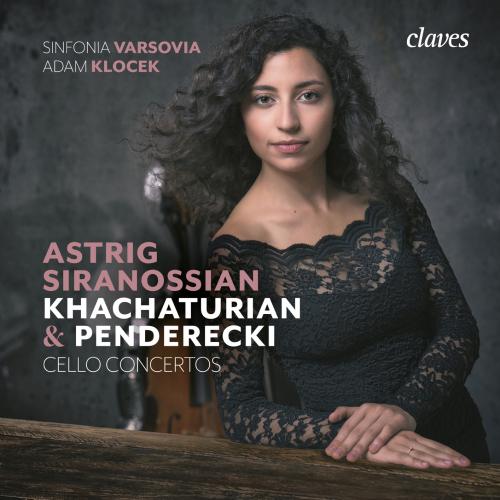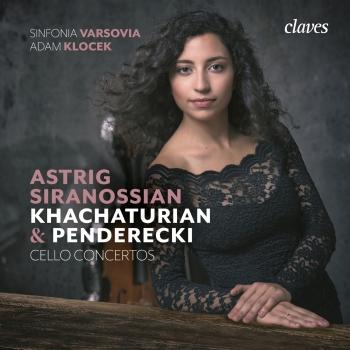
Khachaturian & Penderecki: Cello Concertos Astrig Siranossian, Adam Klocek & Sinfonia Varsovia
Album Info
Album Veröffentlichung:
2018
HRA-Veröffentlichung:
18.01.2019
Label: Claves Records
Genre: Classical
Subgenre: Concertos
Interpret: Astrig Siranossian, Adam Klocek & Sinfonia Varsovia
Komponist: Krzysztof Penderecki (1933), Aram Ilich Khachaturian (1903-1978)
Das Album enthält Albumcover
- Aram Khachaturian (1903 - 1978): Cello Concerto in E minor:
- 1 I. Allegro moderato 16:04
- 2 II. Andante sostenuto - Attacca 08:24
- 3 III. Allegro (a battuta) 09:13
- Krzysztof Penderecki (1933 - ):
- 4 Andante con moto 10:34
- 5 Poco meno mosso 04:14
- 6 Allegretto 03:18
- 7 Lento 08:07
- 8 Allegretto 2 04:50
- 9 Finale 05:11
Info zu Khachaturian & Penderecki: Cello Concertos
Khachaturian: Cello Concerto in E minor: First performed on 30th October 1946 in the Great Hall of the Moscow Conservatory in the very midst of the Soviet turmoil, the Cello Concerto was the last of a series of three concertos, such as those for violin or piano, to be presented with Sviatoslav Knouchevitski (dedicatee) on the cello and Aleksandr Gauk conducting. Though first performed in 1946, it was written many years earlier while the composer was studying cello at the Gnessin Institute. The “Stalin Prize” (1941) for his First Violin Concerto (that contributed to his international fame) as well as his Third Symphony, first performed in 1947 for the thirtieth anniversary of the October Revolution, did not prevent him, following the 1948 Zhdanov Decree, to be accused - as were Prokofiev and Shostakovich - of writing hermetic, formalist music with misunderstood dissonances. Being barred from the Union of Soviet Composers left a strong mark on the three friends.
The Cello Concerto in E minor is a reflexion of Khachaturian’s early love of the opera. Often described as a “Symphonie Concertante”, it features the rhythmic, melodic, virtuoso and popular aspects of music of the period. The long cadenza of the first movement precedes the “Sonata-Fantasia” for cello solo by Khachaturian published in 1974 and includes several Caucasian themes that are closely related to the history of his family.
In 1962 he wrote, in collaboration with Mstislav Rostropovich, a Concerto Rhapsody in a less lyrical language, opening the way for a more avant-garde style of writing for the cello which is undeniably found in Penderecki’s Second Concerto.
Penderecki: Cello Concerto No. 2: First performed in 1982 by Mstislav Rostropovich, Penderecki’s Second Concerto for Cello and Orchestra is composed in one single movement: its architectural vision - in an arch style, including several cadenzas for the solo instrument - maintains a dramatic atmosphere throughout the work. The composer, having been a forerunner in the use of classical instruments as percussion in serial writing in the 60s, returned however to a post-romantic language in the 80s. As in several of these cello pieces, Penderecki builds on the heritage of the percussive use of this instrument (his First Cello Concerto created in 1972 is a perfect example of this) and heralds a new period inspired by his liking for sacred music.
Rather like Khachaturian but in a more avant-garde language, the idea of dramatisation is very present in this Second Cello Concerto. The use of clusters, glissandi, rests, masses of sound and immersion of extremely tonal passages create a stage set for this work. Indeed it is no wonder that Penderecki’s music was used in many films such as “The Exorcist” by William Peter Blatty in 1973, Stanley Kubrick’s “The Shining” in 1980, or Martin Scorsese’s “Shutter Island” in 2010. With these two works, Khachaturian and Penderecki offer a most complete vision of the use of the cello as solo instrument, supported by very dense orchestration.
Astrig Siranossian, cello
Sinfonia Varsovia
Adam Klocek, conductor
Astrig Siranossian
Winner of the First Prize and several times winner of the Special Prize of the Krzysztof Penderecki International Cello Competition, Astrig Siranossian performs as soloist with famous orchestras. A regular guest of Daniel Barenboim’s, her musical partners are no less than Simon Rattle, Antonio Pappano, Yo-Yo Ma, Sol Gabetta, Bertrand Chamayou, Daniel Ottensamer… The most well-known venues have already hosted the young musician: Paris Philharmonic, Musikverein in Vienna, KKL Luzern, Basel Casino, Dijon Opera, Flagey in Brussels, Teatro Colon Buenos Aires, Kennedy Center Washington….
The recording made in 2016 by the Claves Records label and dedicated to Gabriel Fauré, Francis Poulenc and Komitas was greatly acclaimed by critics, including the Musica Prize. She obtained a “coup de coeur” by the French-speaking Belgian Radio- Television during the 2017 Queen Elisabeth competition.
Astrig Siranossian has been artist in residence since 2015 at the Queen Elisabeth Music Chapel as well as the Singer-Polignac Foundation. She has recorded a chamber music CD with the Évidence label dedicated to Franz Schubert, which will be published in 2018. In 2016, she became Artistic Director of the Musicades Romanesques, festival of the town of Romans that mirrors music with art as well as with gastronomy.
Astrig Siranossian started music at the age of three. Five years later she was admitted to the CNR in Lyon, furthered her studies at the Lyon CNSM in Lyon, obtaining her diploma of higher studies with distinction. She completed her training in Switzerland at the Basel Conservatory in Ivan Monighetti’s class, passing her Concert Masters and Soloist Masters Degree with flying colours.
Astrig plays a 1676 Ruggieri cello, generously loaned by the Boubo Music Foundation in Binningen.
Dieses Album enthält kein Booklet










